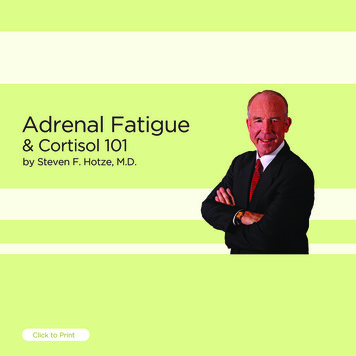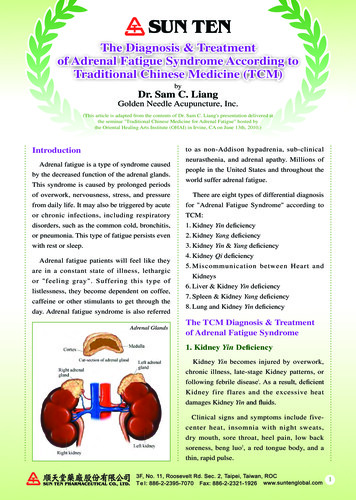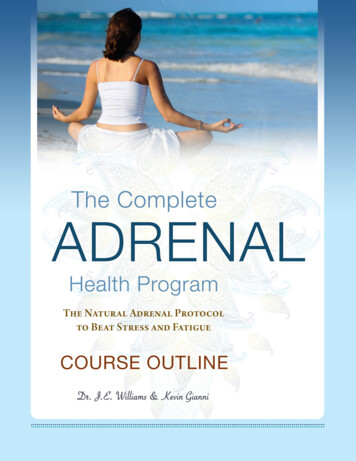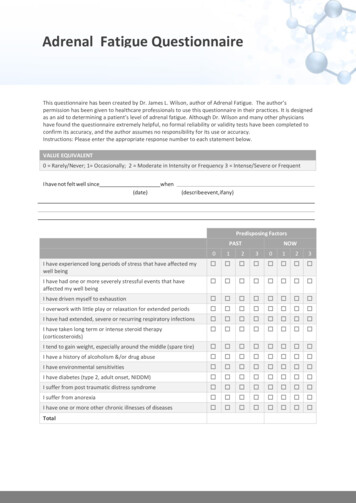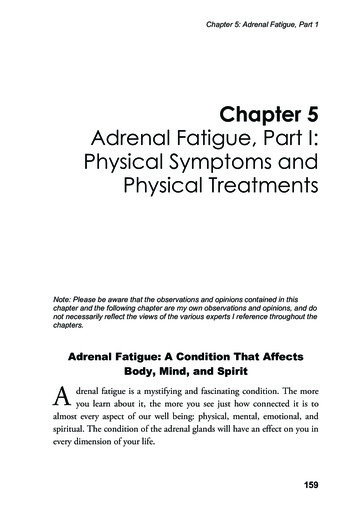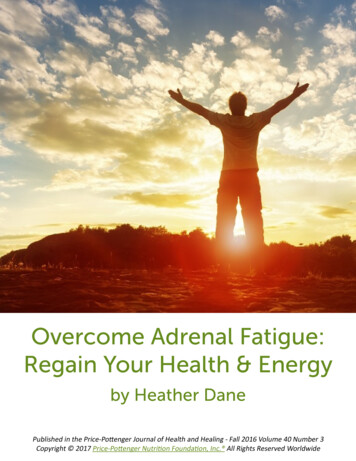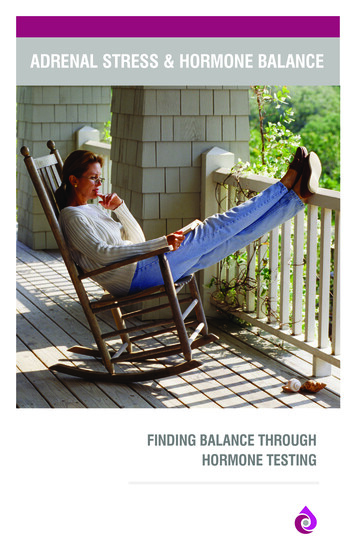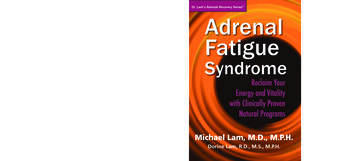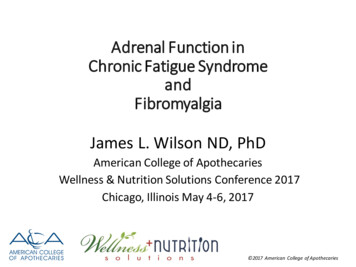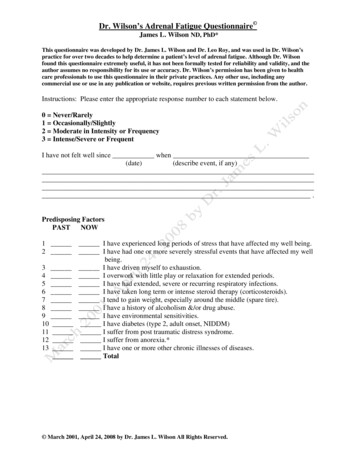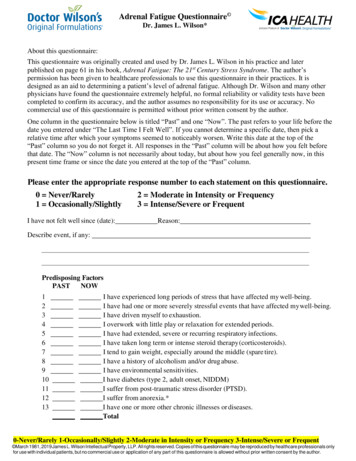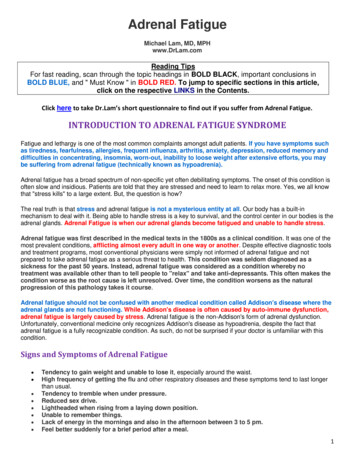
Transcription
Adrenal FatigueMichael Lam, MD, MPHwww.DrLam.comReading TipsFor fast reading, scan through the topic headings in BOLD BLACK, important conclusions inBOLD BLUE, and " Must Know " in BOLD RED. To jump to specific sections in this article,click on the respective LINKS in the Contents.Click here to take Dr.Lam’s short questionnaire to find out if you suffer from Adrenal Fatigue.INTRODUCTION TO ADRENAL FATIGUE SYNDROMEFatigue and lethargy is one of the most common complaints amongst adult patients. If you have symptoms suchas tiredness, fearfulness, allergies, frequent influenza, arthritis, anxiety, depression, reduced memory anddifficulties in concentrating, insomnia, worn-out, inability to loose weight after extensive efforts, you maybe suffering from adrenal fatigue (technically known as hypoadrenia).Adrenal fatigue has a broad spectrum of non-specific yet often debilitating symptoms. The onset of this condition isoften slow and insidious. Patients are told that they are stressed and need to learn to relax more. Yes, we all knowthat "stress kills" to a large extent. But, the question is how?The real truth is that stress and adrenal fatigue is not a mysterious entity at all. Our body has a built-inmechanism to deal with it. Being able to handle stress is a key to survival, and the control center in our bodies is theadrenal glands. Adrenal Fatigue is when our adrenal glands become fatigued and unable to handle stress.Adrenal fatigue was first described in the medical texts in the 1800s as a clinical condition. It was one of themost prevalent conditions, afflicting almost every adult in one way or another. Despite effective diagnostic toolsand treatment programs, most conventional physicians were simply not informed of adrenal fatigue and notprepared to take adrenal fatigue as a serious threat to health. This condition was seldom diagnosed as asickness for the past 50 years. Instead, adrenal fatigue was considered as a condition whereby notreatment was available other than to tell people to "relax" and take anti-depressants. This often makes thecondition worse as the root cause is left unresolved. Over time, the condition worsens as the naturalprogression of this pathology takes it course.Adrenal fatigue should not be confused with another medical condition called Addison's disease where theadrenal glands are not functioning. While Addison's disease is often caused by auto-immune dysfunction,adrenal fatigue is largely caused by stress. Adrenal fatigue is the non-Addison's form of adrenal dysfunction.Unfortunately, conventional medicine only recognizes Addison's disease as hypoadrenia, despite the fact thatadrenal fatigue is a fully recognizable condition. As such, do not be surprised if your doctor is unfamiliar with thiscondition.Signs and Symptoms of Adrenal Fatigue Tendency to gain weight and unable to lose it, especially around the waist.High frequency of getting the flu and other respiratory diseases and these symptoms tend to last longerthan usual.Tendency to tremble when under pressure.Reduced sex drive.Lightheaded when rising from a laying down position.Unable to remember things.Lack of energy in the mornings and also in the afternoon between 3 to 5 pm.Feel better suddenly for a brief period after a meal.1
Often feel tired between 9 - 10 pm, but resist going to bed.Need coffee or stimulants to get going in the morning.Crave for salty, fatty, and high protein food such as meat and cheese.Increase symptoms of PMS for women; period are heavy and then stop, or almost stopped on the 4thday, only to start flow again on the 5th or 6th day.Pain in the upper back or neck with no apparent reasons.Feels better when stress is relieved, such as on a vacation.Difficulties in getting up in the morningLightheadedOther signs and symptoms include: Mild depression Food and or inhalant allergies Lethargy and lack of energy Increased effort to perform dailytasks Decreased ability to handle stress Dry and thin skin Hypoglycemia Low Body Temperature Nervousness Palpitation Unexplained hair loss Alternating constipation and diarrhea DyspepsiaIf you have many of these signs and symptoms, it is time you consider adrenal fatigue as a possiblecause once you have ruled out other organic pathologies. None of the signs or symptoms by itself candefinitively pinpoint adrenal fatigue. When taken as a group, these signs and symptoms do form a specificadrenal fatigue syndrome or picture - that is - of a person under stress. These signs and symptoms are oftenthe end result of acute severe or chronic excessive stress and the inability of the body to reduce suchstress. Stress, once a "basket" term used by physicians to explain non-specific symptoms undetectable byconventional blood test, is of no mystery to the body at all.The ability to handle stress, physical or emotional, is a cornerstone to human survival. Our body has a completeset of stress modulation system in place, and the control center is the adrenal glands. When this gland becomesdysfunctional, our body's ability to handle stress reduces.ADRENAL GLANDS BASICSThe adrenal glands are two small glands, each about the size of a large grape. They are situated on top of thekidneys. Their purpose is to help the body to cope with stress and help it to survival. Each adrenal gland has twocompartments. The inner or medulla modulate the sympathetic nervous system through secretion andregulation of two hormones called epinephrine and nor epinephrine that are responsible for the fight orflight response. The outer adrenal cortex comprises 80 percent of the adrenal gland and is responsiblefor producing over 50 different types of hormones in three major classes - glucocorticoids,mineralcorticoids and androgens.The most important glucocorticoid is cortisol. When this is lowered, the body will be unable to deal withstress. This happens in adrenal fatigue.Mineralcorticoids such as aldosterone modulate the delicate balance of minerals in the cell, especiallysodium and potassium. It therefore regulates our blood pressure and fluid in the body. Stress increasesthe release of aldosterone, causing sodium retention (leading to water retention and high blood pressure) andloss of potassium and magnesium in early stages of adrenal fatigue. Magnesium is involved in over 300enzymatic reactions in the body. When the body lacks magnesium, it will suffer from a variety of pathologicalconditions such as cardiac arrhythmias and uterine conditions like fibroids and endometriosis.The adrenal cortex is also responsible for producing all sex hormones, although in small amounts. Oneexception is DHEA, a weak androgenic hormone that is made in large amounts in both sexes. DHEA, togetherwith testosterone and estrogen, are made from Pregnenolone.Pregnenolone also leads to the production of progesterone and as one of the intermediary steps in the making ofcortisol. Pregnenolone is therefore one of the most important intermediate hormones being produced in2
the hormonal cascade. Prolonged deficiencies in pregnenolone as that in adrenal fatigue will lead to reductionof both glucocorticosteroids and mineralcorticoids such as cortisol and aldosterone respectively.Cortisol (The Hormone of Death)The most important anti-stress hormone in the body is cortisol. Cortisol protects the body fromexcessive and adrenal fatigue by:Normalizes blood sugar - Cortisol increase blood sugar level in the body, thus providing the energy for thebody to physically escape threat of injury in order to survive. Cortisol works in tandem with insulin from thepancreas to provide adequate glucose to the cells for energy. More energy is required when the body is understress from any source, and cortisol is the hormone that makes this happens. In adrenal fatigue, more cortisol issecreted during the early stages. In later stages of adrenal fatigue (when the adrenal glands become exhausted),cortisol output is reduced.Anti-inflammation Response - Cortisol is a powerful anti-inflammatory agent. When we have a minor injury or amuscle strain, our body's inflammatory cascade is initiated, leading to swelling and redness commonly seenwhen an ankle is sprained or an insect bite. Cortisol is secreted as part of the anti-inflammatory response. Itsobjective is to remove and prevent swelling and redness of other tissues that haven’t been injured. These antiinflammatory responses prevent mosquito bites from enlarging, bronchial tress and eyes from swelling shut fromallergies, and adrenal fatigue.Immune System Suppression - People with high cortisol levels are very much weaker from the immunologicalpoint of view. Cortisol influences most cells that participate in the immune reaction, especially white blood cells.Cortisol suppresses white blood cells, natural killer cells, monocytes, macrophages, and mast cells. It alsosuppresses adrenal fatigue.3
Vaso-constriction - Cortisol contracts mid-size arteries. People with low cortisol (as in advance stages ofadrenal fatigue) have low blood pressure and reduced reactivity to other body agents that constrict bloodvessels. Cortisol tends to increase blood pressure that is moderated.Physiology of Stress - People with adrenal fatigue cannot tolerate stress and will then succumb to severestress. As their stress increases, progressively higher levels of cortisol are required. When the cortisol levelcannot rise in response to stress, it is impossible to maintain the body in optimum stress response. In thisrespect, we can conclude that stress does kill.In summary, cortisol sustains life via two opposite but related kinds of regulatory actions: releasing andactivating of existing defense mechanisms of the body and shutting down and modifying the samemechanisms to prevent them.Cortisol RegulationThe adrenal glands are controlled via the hypothalamus-pituitary-adrenal (HPA) axis. There is an existingnegative feedback loop that governs the amount of adrenal hormones secreted under normalcircumstances in people with adrenal fatigue. For example, the HPA axis adjusts cortisol levels according to thebody's need via a hormone called Adrenal Corticotrophic Hormone (ACTH) that is secreted from the pituitarygland in response to signals from the hypothalamus. When the ACTH binds to the walls of the adrenal cells, achain reaction occurs within the cell. This leads to the release of cholesterol where it is manufactured intopregnenolone, the first hormone in the adrenal cascade. After this, cortisol is released into the blood streamwhere it travels in the circulatory system to all parts of the body and back to the hypothalamus, where it isneutralized.Cortisol and ACTH are not secreted uniformly throughout the day. They follow a diurnal pattern, with thehighest level secreted at around 8:00 a.m. in the morning after which there is a gradual declinethroughout the day. Episodic spikes during the day can also occur when the body is stressed or whencertain foods are taken. The cortisol level is at its lowest between midnight and 4:00 a.m.COMMON CAUSES OF ADRENAL FATIGUEChronic stress is very common in the western society. The most common causes of stress are work pressure,death of a love one, moving house, changing jobs, illness and marital disruptions. Adrenal fatigue occurs whenthe amount of stress overextends the capacity of the body to compensate and recover from stress.Stressors that can lead to adrenal fatigue include: AngerChronic fatigueChronic illnessChronic infectionChronic painDepressionExcessive exerciseFear and guiltGluten intoleranceLow blood sugarMal-absorptionMal-digestionToxic exposure (chemicals, medications, drugs, food additives, preservatives, etc.)Severe or chronic stressSurgeryLate hoursSleep deprivationExcessive sugar in dietExcessive caffeine intake from coffee and tea4
One of the most commonly overlooked causes of adrenal fatigue is chronic or severe infection that givesrise to an inflammatory response. Such infection can occur sub-clinically with no obvious signs at all.Parasitic and bacterial infections including Giardia and H. pylori are often the main culprits.HOW STRESSORS AFFECT THE BODYWhen a person is stressed, the body reacts by mounting a stress response through the stimulation of thesympathetic nervous system. This is also called the ";fight or flight" response as the body arms itself to face whatit perceives as danger. When this happens, epinephrine is secreted from the adrenal medulla, and thehypothalamus-pituitary axis is stimulated to release ACTH, which in turn causes the adrenal cortex to increaseproduction of the anti-stress hormone cortisol.When a person experiences chronic stress, the cortisol level may rise to such a high level that its productionreduces as the adrenal becomes exhausted. At the same time, DHEA, a hormone normally produced in theadrenal glands, will start to decrease with stress without hitting a peak first (as in the case of cortisol). Withchronic stress, there is decompensation of DHEA with concurrent rise of cortisol. As a result, the ratio of cortisolto DHEA increases.As with most hormonal systems, there is a negative feedback system in the body to limit the production of eachhormone. The same occurs in the case of cortisol, with one exception. During prolonged or acute stress whenthe body perceives that its survival is at stake, the excessive cortisol output actually blunts the negativefeedback response. In other words, instead of a negative feedback system to shut down cortisolproduction when the total cortisol is high, the body reacts in the opposite way. As cortisol is the antistress hormone, the body will interpret a very high cortisol level and impending danger. When thishappens, the high cortisol exerts a dampening effect on the negative feedback system instead in orderthat we can survive this threat. More cortisol will therefore be produced. This is the body's way to ensurethat we can cope with the on-going stress that threatens its survival.When our body is stressed, our cortisol level rises in an environment where the negative feedback system isdampened. While this is happening, our DHEA level continues to drop. The result is a high cortisol to DHEAratio and:1. Reduced insulin sensitivity, reduced glucose utilization and increased blood sugar, which lead to diabetes.2. Reduced secretory IgA (the main cellular defense factor), natural killer (NK) cell and T-lymphocyte activity.This leads to increase chances of getting infections such as Herpes, yeast overgrowth, and viralinfections.3. Increased loss in bone mass as calcium absorption is blocked and demineralization of bone occurs, thusleading to osteoporosis.4. Increased fat accumulation around the waist and protein breakdown, thus leading to muscle wasting andinability to reduce weight.5. Increased water and salt retention, leading to high blood pressure at first, with low blood pressure as thecondition worsen6. Estrogen dominance, leading to PMS, uterine fibroids, and breast cancer.STRESS RESPONSE From a Hormonal PerspectiveAt work, what happens if your boss screams at you? Let us now examine some of the effects within our bodyfrom a hormonal perspective. Your hypothalamus signals your pituitary gland to release ACTH.The ACTH will stimulate the adrenal medulla to secreted epinephrine, and the adrenal cortex to secretecortisol, among other hormones.5
Your cortisol level will increase and convert more stored glycogen into blood sugar for energy. Energy isalso increased from the release of epinephrine from the adrenals.Your heart rate will increase (from the epinephrine)You will tend to sweat more (from cortisol)Your muscle tension will increase (from cortisol and epinephrine)Your digestion will slow down as blood is diverted away to more important tissues.Your bladder and rectum muscle may relax.When the above physiological response occurs over a long duration or in certain cases when there is acutestress, then adrenal fatigue can result as the adrenal glands become worn out.ADRENAL FATIGUE PROGRESSIONDiseases progresses through stages normally as the body decompensates. Let us take a closer look:Stage 1: Alarm Reaction (Flight or Fight response)In this stage, the body is alarmed by the stressors and mounts an aggressive anti-stress response to reducestress levels. Some doctors called this the Early Fatigue stage.Typically, there is an increased ACTH from the pituitary gland that stimulates the adrenal glands into full gear tomount a retaliation response. The adrenal medulla is stimulated to secrete more epinephrine, and the totalcortisol output from the adrenal cortex is increased from the excitatory stimulus. There is a correspondingreduction in DHEA production. During this period, the body needs cortisol to overcome stress, andproduction of cortisol is therefore increased. After some time, the adrenals will experience difficulties inmeeting the body's ever increasing demand for cortisol.Stage 2: Resistance ResponseWith chronic or severe stress, the adrenals eventually are unable to keep up with the body's demand for cortisol.As such, the cortisol output will start to decline from a high back to a normal level, while the ACTH remains high.With protracted ACTH and adrenal fatigue, less cortisol is produced due to the adrenal becoming exhausted.While the morning, noon, or afternoon cortisol levels are often low, the night time cortisol level is usually normal.Anxiety starts to set in, and the person becomes easily irritable. Insomnia becomes more common, as ittakes longer to fall asleep. There is also frequent awakening as well. Infections can become morerecurrent. PMS and menstrual irregularities surface, and symptoms suggestive of hypothyroidism (suchas a sensation of feeling cold and sluggish metabolism ) become prevelant.A phenomenon called “pregnenolone steal” (also called “cortisol shunt”) sets in. Cortisol production becomes thepredominant pathway of hormone production as the body favors the production of this hormone. Other hormonessuch as pregnenolone, DHEA, testosterone and estrogen are less favoured and their production will decline. Asa result, total pregnenolone output is reduced but total cortisol output continues to be maintained at a normallevel. Careful analysis of the daily diurnal cycle of cortisol shows a dysfunctional pattern of abnormally lowcortisol in the morning. This is a time when cortisol is needed the most. Nighttime cortisol is usually still normal.Stage 3: Adrenal ExhaustionDespite rising ACTH, the adrenals are no longer able to keep up the increased demand for cortisol production.This may happen over a few years. Total cortisol output is therefore reduced, and DHEA falls far below average.The night time cortisol level is usually reduced as the hypothalamic-pituitary-adrenal axis "crash" and the body isunable to maintain homeostasis. Early in this stage, mild symptoms characteristic of first and secondstage adrenal fatigue continues to worsen and becomes persistent or chronic. As the condition getsworse, multiple endocrine axis imbalances tend to occur. This is commonly manifested in the form ofovarian-adrenal-thyroid (OAT) axis imbalance in female and adrenal-thyroid axis imbalance in the male.As the body continues its downward path of impaired function, it gathers steam. Gradually, the body becomesseverely compromised in trying to maintain the fine controls of homeostasis. Normal equilibrium istherefore lost. The body enters a state of reactive disequilibrium.6
The body will try its hardest maintain equilibrium with activation of the autonomic nervous system (ANS), but itscrude response and damaged receptor sites along with impaired metabolic, clearance, and detoxificationpathways give rise to paradoxical , unpredictable, and exaggerated outcome. Reactive sugar imbalances, fragileblood pressure, postural hypotension, heart palpitations, POTS, dizziness, anxiety reactions, being "wired andtired", periodic adrenaline rushes, fragile fluid state such as hypersensitive dilutional hyponatremia, sudden onsetof anxiety and sensation of impending doom are common. There is a strong mind-body connection. No system isspared as every thought process invokes physiological responses. Many of these symptoms represent whatis known as a "reactive sympathoadrenal response". This response is the result of over-activation of twocomponents of the ANS - the sympathetic nervous system (SNS) and the adrenomedullary hormonalsystem (AHS). Collectively, these two components constitute the sympathoadrenal system (SAS). Whenthe SAS is over-activated due to stress, the body is bathed in a sea of adrenaline and norepinephrine.These two hormones are responsible for many of the above mentioned symptoms.Finally, as the body's key hormones, such as cortisol, falls below the minimum required reserve fornormal function and output fails, the body may down-regulates the amount needed in order to preservewhat is on hand for only the most essential body functions. This near-failure state is quite serious andrequires professional attention. This is a state of extreme low energy as the body tries to conserve tosurvive. Nutrients that normally are helpful may be blunted in this action and indeed may backfire withparadoxical responses being the hallmark. Traditional macro-nutritional approaches may be helpful but theclinical outcome overtime is often blunted and may fail if the body continues to decompensate. In such a case, acarefully titrated micro-nutritional program may be necessary to facilitate restoration of equilibrium.Stage 4: FailureEventually, the adrenals are totally exhausted. When adrenal fatigue has advanced to this stage, the linebetween it, sub-clinical and clinical Addison's disease, also called adrenal insufficiency, can be blurry.Typical symptoms of Addison's Disease may start to emerge. Fatigue becomes extreme, with weight loss,muscle weakness, loss of appetite, nausea, vomiting, hypoglycemia, headache, sweating, irregularmenstrual cycles, depression, and orthostatic hypotension, dehydration, and electrolyte imbalances.The body appears to have lost its normal homeostasis and is breaking down. If not attended to, the naturalprogression of this condition may be fatal.7
Why Conventional Medicine MissedDespite sub-clinical Adrenal Fatigue with its various stages, as was recognized as a distinct clinical syndromesince the turn of the 20th century, most doctors are unfamiliar with this condition for the simple reason that it isdifficult to diagnose effectively by traditional blood test. Normal blood tests are designed to detect severeabsolute deficiency of adrenal hormones known as Addison's disease. This disease afflicts only 4 out of 100,000and is often the result of auto-immune disease or infectious origin. Blood tests are also useful to detect extremeexcessive levels of adrenal hormones in a condition known as Cushing's disease.Let's examine this in more detail. The conventional test used is called the ACTH (adrenocorticotropic hormone)challenge test. This test recognizes extreme underproduction or overproduction of hormone levels, as shown bythe top and bottom 2 percent of a bell curve. In other words, adrenal function has to be extreme low ( the bottom2 percent) before a diagnosis is made. Symptoms of non-Addison’s adrenal malfunction, meanwhile, can start topresent itself symptomatically after 15 percent deviation from the mean on the bell curve. Therefore, theadrenal glands could be functioning anywhere from 15-48 percent below the norm and not detected by the ACTHtest.To sum it up, adrenal hormones are low in the case of Adrenal fatigue, but still within the "normal" rangeand not low enough to warrant the diagnosis of Addison's disease by regular blood tests. Such "normal"level of adrenal hormones does not mean that the patient is free from adrenal malfunction. Conventionaldoctors are not taught the significance of sub-clinical Addison's Disease, or Non-Addison's Hypoadrenia(commonly referred to as adrenal fatigue). They are misguided by blood tests. As a results, patients tested foradrenal functions are told they are "normal" but in reality, their adrenal glands are performing suboptimally, with clear signs and symptoms as the body cries out for help and attention.LABORATORY TESTAdrenal fatigue has been demonstrated in laboratory studies of surrogate markers of adrenal function. Two suchmarkers used are cortisol and DHEA by serum. These two markers by blood give a general picture of thebody as to whether it is in anabolic (build up) or catabolic state ( breakdown). It is not diagnostic.Another way to test your adrenal health is to measure your level of free key adrenal hormones such as cortisoland DHEA. Saliva testing is preferred as it measures the amount of free and circulating hormones andthus more accurate , but again, this is not diagnositic.DHEA can be measured anytime during the day. Cortisol, on the other hand, is the highest in themorning and lowest in the evening before bedtime. Taking 4 samples of cortisol (at 8 am, noon, 5 pm, andbefore bedtime) is desirable if saliva test is undertaken. With multiple samples taken throughout the day, we areable to map the daily diurnal curve of free cortisol in the body relative to DHEA level. This will give us a muchclearer picture of adrenal function.If you are taking oral or applying topical supplemental hormone creams such as DHEA or pregnenolone,the saliva test results may be elevated immediately. Blood test results will also increase, but it will takeabout 3 months to show.Stress can also affect the levels of adrenal hormones. Your cortisol level tested after a quiet and relaxingmorning will be very different from that taken when you are under tremendous stress.To rule out sub-clinical infection as a cause of adrenal fatigue, specialized test measuring the immunoglobulinresponse may be necessary as normal culture for bacteria and parasites will often be negative.WARNING: Due to tremendous individual variance and the body's constant changing state, laboratorytests should be undertaken judiciously under the right setting and only when needed in order to be costeffective and relevant. It is not uncommon to have adrenal fatigue symptoms with "normal" laboratoryresults, and vice versa. Furthermore, in advance adrenal fatigue, the 24 hour cortisol curve invariablybecomes flattened most of the time and can stay that way for an extended period of time, even duringrecovery. Therefore, one can be easily confused as test results can be misleading. Over-reliance on test isa common adrenal recovery mistake.8
A good history by an astute and and experieiinced clinician is by far the best and most accurate way toascertain adrenal fatigue status and is far better than any laboratory testing.Laboratory tests are best used as supporting tools under the guidance of the right health professionaland should not be relied on as a sole gauge of adrenal function and therapeutic options. Consumersoften make the mistake of embarking on a self-guided nutritional recovery program that relies onlaboratory test without understanding their limitations. Over time, this approach often leads to improperuse of nutrients which makes the condition worse.Paradoxical ReactionsIn adrenal fatigue, the body can often exhibit multiple paradoxical reactions that one does not normallyexpect. These include:a. A sense of fatigue or malaise instead of a sense of calm when taking steroidsb. A sudden onset of anxiety attacks and impending doom at restc. Sudden onset of heart palpitations despite normal cardiac functiond. Sudden onset of dizziness and light-headedness at rest, or after stressful situation, or after taking certaintypes of food, especially carbohydrates.e. Sudden onset of fluctuating blood pressuref. Staying in bed for an extended period of time with no energy to get up even after a full night's restg. A sense of being "beaten up" that lasts for days after vigorous exerciseh. Inability to think clearly and difficulty recalling even a recent problemi. Waking up in the middle of the night for no reason and the inability to go back to sleepj. Being constipated instead of having loose bowel when taking high doses of vitamin C or magnesiumk. A sense of getting wired up and anxious after taking Vitamin C, adrenal glandular, or herbsl. Getting more toxic instead of feeling better when going through a detoxification program like juice fasting.m. Sudden onset of fragile emotional states such as crying for no apparent reasonn. Taking multiple trips to the Emergency Room because one feels impending doom even though one istold that nothing is wrong after a complete work-up.o. A sense of well-being after taking selected nutrients, only to be followed by a "crash"p. Fluid retention/depletion in a setting that is highly sensitive to sodium load that is hard to maintain.One can have any combination of the above. The exact pathophysiology of each of these symptoms is not fullyknown. Collectively, they point to an adrenal that has lost its ability to maintain the fine control necessaryof a stable internal homeostasis environment. Self-directed recovery programs normally fail in suchcases because normal healing tools do not apply. It is best to consult a professional for help if you havea significant number of these paradoxical reactions.9
WOMEN AND ADRENALSOvarian Adrenal Thyroid (OAT) Axis Imbalance. There are very strong interlinked relationships between theovarian, adrenal, and thyroid systems in the women. These three organs are intimately co-dependent on eachother for optimal function. This axis, also called the Ovarian Adrenal and Thyroid axis (OAT), must bebalanced if a woman wants to feel good. When medication alters one of the organ's functions, it willinvariably lead to an often unrecognized change in the other two organs. For example, if thyroid medicationis administered, it is not uncommon to see concurrent menstrual irregula
adrenal fatigue is largely caused by stress. Adrenal fatigue is the non-Addison's form of adrenal dysfunction. Unfortunately, conventional medicine only recognizes Addison's disease as hypoadrenia, despite the fact that adrenal fatigue is a fully recognizable condition. As such, do not be surprised if your doctor is unfamiliar with this condition.
